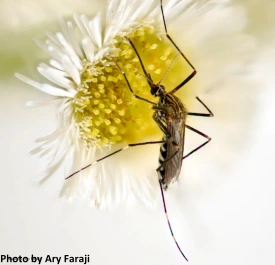This page summarizes ongoing research. For prior projects refer to the Publications page.
 Disease Vectors in a Changing World: exotics and native invaders
Disease Vectors in a Changing World: exotics and native invaders
Hawaii’s spectacular honeycreepers are dying of exotic bird malaria transmitted by exotic Culex mosquitoes [Fonseca et al 2006]. To develop predictive models of the impact of co-evolutionary changes on vector-borne disease transmission under current and future climate scenarios we are using comparative genomics and transcriptomics at multiple spatial, temporal and experimental scales. [Funding: NSF Ecology and Evolution of Infectious Diseases – 2017:2021]
Closer to home, we are also examining patterns of northern expansion of the southern mosquitoes Culex erraticus, Aedes atlanticus and Ae. tormentor. These are native invaders (sensu Simberloff et al. 2011). Unlike exotic vectors such as Ae. albopictus that specialize in anthropogenic landscapes, native invaders can reach high densities in relatively untouched environments, putting local wildlife at risk. [ms on Cx. erraticus submitted to EcoHealth; ms on Aedes atlanticus is in preparation]
However, native species such as Cx. restuans have also started to adapt to human environments (another type of native invader) and facilitate and amplify pathogen transmission to humans [Johnson et al 2015].
 Salt Marsh Mosquitoes and Marsh Resilience
Salt Marsh Mosquitoes and Marsh Resilience
How will salt marsh mosquitoes respond to changes in the salt marsh due to climate change (sea level rise) and marsh resilience efforts? Do marsh mosquito mitigation efforts affect marsh resilience? Uncontrolled salt marsh mosquitoes are a very significant nuisance and can vector the viral agents of Eastern Equine and West Nile encephalitides. [Funding: NOAA-NERRS Science Collaborative Research – 2017:2020]

Brown marmorated stinkbug
eDNA for early detection of terrestrial exotic species
Our methodology [Valentin et al 2016; Valentin et al submitted] is transferable to any terrestrial situation where target species’ DNA can be aggregated, suggesting eDNA can potentially transform our ability to respond to biosecurity threats across terrestrial ecosystems. [Funding: USDA-NIFA graduate fellowship to Rafael Valentin – 2017:2018; Farm Bill – pending]
To learn more about eDNA in terrestrial settings, you can either continue your search in the Fonseca Lab webpage or visit InSiTe.
Tick-Borne Pathogen Ecology

Dermacenter variabilis
Tick borne diseases affect thousands of Americans every year, yet tick ecology, epidemiology and control are still sorely understudied. We are developing strategies for effective surveillance and employing molecular approaches to specifically identify pathogens and primary blood hosts. [Funding: Northeast Integrated Pest Management]

Aedes japonicus japonicus
Human-mediated Species Expansion
High resolution genetic analyses of Aedes japonicus japonicus, the Asian bush mosquito, reveals that transportation by humans drives their expansion post-introduction [Egizi et al. 2016]. We hypothesize that human-mediated mixing combines adapted traits resulting in domesticated populations more likely to thrive amongst us and bite us.
Population genetic analysis of the worldwide expansion of the brown marmorated stinkbug, Halyomorpha halys, reveals multiple introductions from China not expansion from single introductions [Valentin et al 2017], an emerging pattern likely driven by increased cross-world trade.
Global Health: the tick that binds us all
Invasive vectors are not just mosquitoes. A tick capable of severely impacting livestock but also a competent vector of deadly human pathogens expanded to Australia and New Zealand last century and could establish populations in the US. Indeed, a multigenerational population was detected in Hunterdon County, NJ during the summer of 2017 (Press release) and was again detected by Jim and Andrea with Tadhgh Rainey (Hunterdon Co. Mosquito Control) support in April 2018 (ExoticTickOverWintersPR). Click on the heading for a summary review of the biology and ecology of this tick species, as well as information on their vectorial capacity.
Emerging Vectors: the invasome

double-rainbow in Hawaii’s Hawaii
Vectors of epidemics are not borne, they are created [Egizi et al 2015]. Mixing of strains of Culex quinquefasciatus from the Old and New World created the vectors of bird malaria in Hawaii [Fonseca et al 2006]. Unidirectional introgression of Culex quinquefasciatus created Cx. pipiens pallens, an Asian domestic species [Fonseca et al, 2009]. Hybrid Culex pipiens, which combine the domesticity of the form molestus and the ability to survive in temperate climates of form pipiens [Fonseca et al 2004] likely drove epidemics of West Nile virus in the US.
